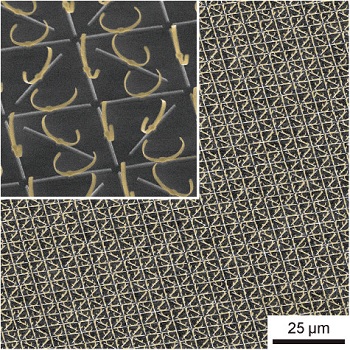Scientists from RIKEN along with researchers from ITRC, NAR Labs in Taiwan have achieved a significant breakthrough by creating a large isotropic metamaterial up to 4 x 4mm² in size using a split-ring resonator (SRR).
 A magnified image, and the total sample area was 4 x 4 mm. Image Credit: RIKEN, Japan.
A magnified image, and the total sample area was 4 x 4 mm. Image Credit: RIKEN, Japan.
Metamaterials are artificially designed using resonant elements in order to have properties that cannot be observed in other natural materials. Until now, scientists were able to engineer three-dimensional isotropic metamaterials at on small scales.
Like any other materials, metamaterials also have certain limitations. They are two-dimensional materials with anisotropic behaviour. However, three-dimensional natural materials appear to be same from all directions.
The research team used a new method of fabrication which integrates top-down electron lithography and a metal-stress driven self-moulding technique. The latter technique is a bottom-up self-moulding mechanism resulting due to metals’ intrinsic stress.
Using the top-down process, a PMMA polymer layer was deposited on a silicon substrate.
A ribbon-shaped ditch was etched on the polymer using electron beam lithography, and a nickel-gold metal strip was deposited on the etched surface. Finally, the metal film surrounding the ditch was removed.
Following this, the bottom-up process was applied in which the team removed the silicon apart from the centre region of the strip. Upon exposure to air, a ring-shaped three-dimensional metamaterial resonator was formed with respect to the stresses on the metal strips.
The tension generated within the materials enabled the folding which, when detected using spectroscopy, displayed isotropic properties on rotation to incident angles of 40°.
The determination of the optical characteristics of the SRR is also based on the three-dimensional electromagnetic numerical calculations.
The research findings present a breakthrough technique of fabricating highly symmetric metamaterials providing isotropic optical responses. This technique could be expanded to build complex three-dimensional meta-atoms stacked with multiple layers, exhibiting remarkable optical properties.
Metamaterials are found to have an ability to create superlenses with diffraction limit greater than that of cloaking devices and conventional lenses. This achievement could help in designing such interesting materials in real-time. This research was published in Advanced Optical Materials.